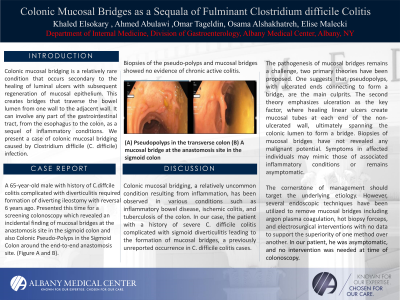Monday Poster Session
Category: Colon
P1969 - Colonic Mucosal Bridges as a Sequala of Fulminant Clostridium difficile Colitis
Monday, October 28, 2024
10:30 AM - 4:00 PM ET
Location: Exhibit Hall E

Has Audio
- KE
Khaled Elsokary, DO
Albany Medical Center
Albany, NY
Presenting Author(s)
Khaled Elsokary, DO1, Ahmad Abulawi, MD1, Omar Tageldin, MD2, Osama Alshakhatreh, MD1, Elise Malecki, MD, PhD3
1Albany Medical Center, Albany, NY; 2Albany Medical Center, Albnay, NY; 3Albany Stratton VA Medical Center, Albany, NY
Introduction: Colonic mucosal bridging is a relatively rare condition that occurs secondary to the healing of luminal ulcers with subsequent regeneration of mucosal epithelium. This creates bridges that traverse the bowel lumen from one wall to the adjacent wall. It can involve any part of the gastrointestinal tract, from the esophagus to the colon, as a sequel of inflammatory conditions. We present a case of colonic mucosal bridging caused by Clostridium difficile (C. difficile) infection.
Case Description/Methods: A 65 year-old male with history of C.diffcile colitis complicated with diverticulitis required formation of diverting ileostomy with reversal 6 years ago. Presented this time for a screening colonoscopy which revealed an incidental finding of mucosal bridges at the anastomosis site in the sigmoid colon and also Colonic Pseudo-Polyps in the Sigmoid Colon around the end-to-end anastomosis site. (Figure A and B). Biopsies of the pseudo-polyps and mucosal bridges showed no evidence of chronic active colitis.
Discussion: Colonic mucosal bridging, a relatively uncommon condition resulting from inflammation, has been observed in various conditions such as inflammatory bowel disease, ischemic colitis, and tuberculosis of the colon. In our case, the patient with a history of severe C. difficile colitis complicated with sigmoid diverticulitis,
leading to the formation of mucosal bridges, a previously unreported occurrence in C. difficile colitis cases. The pathogenesis of mucosal bridges remains a challenge, two primary theories have been proposed. One suggests that pseudopolyps, with ulcerated ends connecting to form a bridge, are the main culprits. The second theory emphasizes ulceration as the key factor, where healing linear ulcers create mucosal tubes at each end of the non-ulcerated wall, ultimately spanning the colonic lumen to form a bridge.
Biopsies of mucosal bridges have not revealed any malignant potential. Symptoms in affected individuals may mimic those of associated inflammatory conditions or remain asymptomatic. The cornerstone of management should target the underlying etiology. However, several endoscopic techniques have been utilized to remove mucosal bridges including argon plasma coagulation, hot biopsy forceps, and electrosurgical interventions with no data to support the superiority of one method over another. In our patient, he was asymptomatic, and no intervention was needed at time of colonoscopy.

Disclosures:
Khaled Elsokary, DO1, Ahmad Abulawi, MD1, Omar Tageldin, MD2, Osama Alshakhatreh, MD1, Elise Malecki, MD, PhD3. P1969 - Colonic Mucosal Bridges as a Sequala of Fulminant <i>Clostridium difficile</i> Colitis, ACG 2024 Annual Scientific Meeting Abstracts. Philadelphia, PA: American College of Gastroenterology.
1Albany Medical Center, Albany, NY; 2Albany Medical Center, Albnay, NY; 3Albany Stratton VA Medical Center, Albany, NY
Introduction: Colonic mucosal bridging is a relatively rare condition that occurs secondary to the healing of luminal ulcers with subsequent regeneration of mucosal epithelium. This creates bridges that traverse the bowel lumen from one wall to the adjacent wall. It can involve any part of the gastrointestinal tract, from the esophagus to the colon, as a sequel of inflammatory conditions. We present a case of colonic mucosal bridging caused by Clostridium difficile (C. difficile) infection.
Case Description/Methods: A 65 year-old male with history of C.diffcile colitis complicated with diverticulitis required formation of diverting ileostomy with reversal 6 years ago. Presented this time for a screening colonoscopy which revealed an incidental finding of mucosal bridges at the anastomosis site in the sigmoid colon and also Colonic Pseudo-Polyps in the Sigmoid Colon around the end-to-end anastomosis site. (Figure A and B). Biopsies of the pseudo-polyps and mucosal bridges showed no evidence of chronic active colitis.
Discussion: Colonic mucosal bridging, a relatively uncommon condition resulting from inflammation, has been observed in various conditions such as inflammatory bowel disease, ischemic colitis, and tuberculosis of the colon. In our case, the patient with a history of severe C. difficile colitis complicated with sigmoid diverticulitis,
leading to the formation of mucosal bridges, a previously unreported occurrence in C. difficile colitis cases. The pathogenesis of mucosal bridges remains a challenge, two primary theories have been proposed. One suggests that pseudopolyps, with ulcerated ends connecting to form a bridge, are the main culprits. The second theory emphasizes ulceration as the key factor, where healing linear ulcers create mucosal tubes at each end of the non-ulcerated wall, ultimately spanning the colonic lumen to form a bridge.
Biopsies of mucosal bridges have not revealed any malignant potential. Symptoms in affected individuals may mimic those of associated inflammatory conditions or remain asymptomatic. The cornerstone of management should target the underlying etiology. However, several endoscopic techniques have been utilized to remove mucosal bridges including argon plasma coagulation, hot biopsy forceps, and electrosurgical interventions with no data to support the superiority of one method over another. In our patient, he was asymptomatic, and no intervention was needed at time of colonoscopy.

Figure: (A) Pseudopolyps in the transverse colon
(B) A mucosal bridge at the anastomosis site in the sigmoid colon
(B) A mucosal bridge at the anastomosis site in the sigmoid colon
Disclosures:
Khaled Elsokary indicated no relevant financial relationships.
Ahmad Abulawi indicated no relevant financial relationships.
Omar Tageldin indicated no relevant financial relationships.
Osama Alshakhatreh indicated no relevant financial relationships.
Elise Malecki indicated no relevant financial relationships.
Khaled Elsokary, DO1, Ahmad Abulawi, MD1, Omar Tageldin, MD2, Osama Alshakhatreh, MD1, Elise Malecki, MD, PhD3. P1969 - Colonic Mucosal Bridges as a Sequala of Fulminant <i>Clostridium difficile</i> Colitis, ACG 2024 Annual Scientific Meeting Abstracts. Philadelphia, PA: American College of Gastroenterology.
